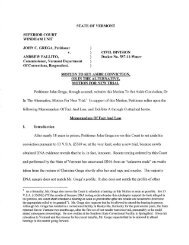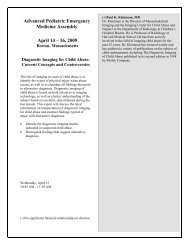Delayed Sudden Death in an Infant Following an Accidental Fall
Delayed Sudden Death in an Infant Following an Accidental Fall
Delayed Sudden Death in an Infant Following an Accidental Fall
You also want an ePaper? Increase the reach of your titles
YUMPU automatically turns print PDFs into web optimized ePapers that Google loves.
Diagnosis of Traumatic<br />
Diffuse Axonal Injury<br />
To the Editor:<br />
In the December 2003 issue of the<br />
Americ<strong>an</strong> Journal of Forensic Medic<strong>in</strong>e<br />
<strong>an</strong>d Pathology, there was a case report<br />
written by Drs. Scott Denton <strong>an</strong>d<br />
Dar<strong>in</strong>ka Mileusnic titled “<strong>Delayed</strong> <strong>Sudden</strong><br />
<strong>Death</strong> <strong>in</strong> <strong>an</strong> Inf<strong>an</strong>t Follow<strong>in</strong>g <strong>an</strong><br />
<strong>Accidental</strong> <strong>Fall</strong>: A Case Report With<br />
Review of the Literature.” This article<br />
presented a case of delayed death <strong>in</strong> a<br />
9-month-old <strong>in</strong>f<strong>an</strong>t as a result of severe<br />
cr<strong>an</strong>iocerebral <strong>in</strong>juries, which were susta<strong>in</strong>ed<br />
from <strong>an</strong> accidental fall <strong>in</strong> the<br />
domestic environment. The authors had<br />
affirmed that there was no evidentiary<br />
f<strong>in</strong>d<strong>in</strong>g of diffuse axonal <strong>in</strong>jury (DAI).<br />
The scientific validity of this assertion<br />
rema<strong>in</strong>s <strong>in</strong> doubt s<strong>in</strong>ce the authors neither<br />
mentioned nor performed <strong>an</strong>y tissue<br />
-amyloid precursor prote<strong>in</strong> (-APP)<br />
immunohistochemical <strong>an</strong>alyses, given<br />
our current level of knowledge <strong>in</strong> the<br />
diagnosis of severe traumatic bra<strong>in</strong> <strong>in</strong>jury,<br />
<strong>in</strong>clud<strong>in</strong>g DAI. 1–6 S<strong>in</strong>ce the 1980s,<br />
tissue immunohistochemistry for -APP<br />
has emerged as the most sensitive methodology<br />
<strong>an</strong>d gold st<strong>an</strong>dard for the detection,<br />
confirmation, <strong>an</strong>d diagnosis of diffuse<br />
<strong>an</strong>d focal axonal <strong>in</strong>jury. With the<br />
absence of <strong>an</strong>y -APP immunohistochemical<br />
confirmation of DAI, what the<br />
authors had referred to as a “laceration”<br />
of the splenium of the corpus callosum<br />
may actually represent Adam’s grade II<br />
DAI 7,8 s<strong>in</strong>ce DAI is accentuated <strong>in</strong> the<br />
splenium of the corpus callosum. 9 In<br />
Adam’s grade I DAI, there is no gross<br />
evidence of axonal <strong>in</strong>jury; however,<br />
there is diffuse -APP immunopositivity<br />
for axonal <strong>in</strong>jury. In Adam’s grade II<br />
DAI, there are gross lesions (parenchymal<br />
hemorrhages) of the corpus callosum,<br />
<strong>in</strong> addition to -APP tissue immunopositivity.<br />
In Adam’s grade III DAI,<br />
there are gross lesions (parenchymal<br />
hemorrhages) of the corpus callosum<br />
<strong>an</strong>d dorsolateral midbra<strong>in</strong>/pons, <strong>in</strong> addition<br />
to diffuse -APP tissue immunopositivity.<br />
7,8<br />
270<br />
LETTERS TO THE EDITOR<br />
-APP is a s<strong>in</strong>gle membr<strong>an</strong>e–<br />
sp<strong>an</strong>n<strong>in</strong>g prote<strong>in</strong>, which is present <strong>in</strong><br />
membr<strong>an</strong>ous structures of the cell such<br />
as the endoplasmic reticulum, Golgi<br />
compartment, <strong>an</strong>d the cell membr<strong>an</strong>e,<br />
encoded by the APP gene localized to<br />
chromosome 21, <strong>an</strong>d is ubiquitously expressed<br />
<strong>in</strong> m<strong>an</strong>y cell <strong>an</strong>d tissue types,<br />
<strong>in</strong>clud<strong>in</strong>g endothelia, glia, <strong>an</strong>d neurons<br />
of the bra<strong>in</strong>. -APP is a resource-rich<br />
molecule that is <strong>in</strong>volved <strong>in</strong> diverse normal<br />
cell functions, be<strong>in</strong>g the center of<br />
m<strong>an</strong>y converg<strong>in</strong>g metabolic <strong>an</strong>d regulatory<br />
pathways, <strong>in</strong>clud<strong>in</strong>g cell adhesion,<br />
<strong>in</strong>tercellular signal<strong>in</strong>g, membr<strong>an</strong>e-to-nucleus<br />
signal<strong>in</strong>g, cholesterol metabolism,<br />
gene tr<strong>an</strong>scription, axonal tr<strong>an</strong>sport, <strong>an</strong>d<br />
neurotrophic <strong>an</strong>d neuroproliferative activity.<br />
1<br />
In the neuron, -APP is synthesized<br />
<strong>in</strong> the perikaryon <strong>an</strong>d tr<strong>an</strong>sported<br />
<strong>an</strong>terogradely <strong>an</strong>d retrogradely <strong>in</strong> the<br />
axon by fast/rapid axonal tr<strong>an</strong>sport (100<br />
to 400 mm/day). In normal, structurally<br />
<strong>in</strong>tact axons, -APP does not accumulate<br />
to a level that allows its detection <strong>in</strong><br />
tissue sections. However, once structural<br />
axonal <strong>in</strong>jury <strong>an</strong>d damage occur<br />
<strong>an</strong>d the fast axonal tr<strong>an</strong>sport is impaired,<br />
-APP accumulates <strong>in</strong> the proximal <strong>an</strong>d<br />
distal axonal segment to a level that<br />
allows its detection by tissue immunohistochemistry<br />
with<strong>in</strong> 1.75 to 3 hours<br />
follow<strong>in</strong>g <strong>in</strong>jury. -APP has been reported<br />
to rema<strong>in</strong> detectable by tissue<br />
immunohistochemistry for up to 99 days<br />
follow<strong>in</strong>g axonal <strong>in</strong>jury. 1,6<br />
For this specified case report by<br />
Scott Denton <strong>an</strong>d Dar<strong>in</strong>ka Mileusnic,<br />
-APP tissue immunohistochemistry<br />
that is performed accord<strong>in</strong>g to the recommended<br />
medicolegal protocol 10 may<br />
reveal grades I or II DAI. This f<strong>in</strong>d<strong>in</strong>g<br />
may additionally <strong>an</strong>d more <strong>in</strong>terest<strong>in</strong>gly<br />
reaffirm that children who susta<strong>in</strong> low<br />
grades of DAI may m<strong>an</strong>ifest a delayed,<br />
symptomatic, or fatal presentation.<br />
Bennet I. Omalu, MD<br />
Division of Forensic Neuropathology<br />
Allegheny County Coroner’s Office<br />
Pittsburgh, Pennsylv<strong>an</strong>ia<br />
REFERENCES<br />
1. Turner PR, O’Connor K, Tate WP, et al. Roles<br />
of amyloid precursor prote<strong>in</strong> <strong>an</strong>d its fragments<br />
<strong>in</strong> regulat<strong>in</strong>g neural activity, plasticity <strong>an</strong>d<br />
memory. Prog Neurobiol. 2003;10:1–32.<br />
2. Smith C, Graham DI, Geddes JF, et al. The<br />
<strong>in</strong>terpretation of Beta-APP immunoreactivity:<br />
a response to C. Neiss et al., Acta Neuropathol<br />
(2002) 104:79. Acta Neuropathol. 2003;106:<br />
97–98.<br />
3. Smith DH, Me<strong>an</strong>ey DF, Shull WH. Diffuse<br />
axonal <strong>in</strong>jury <strong>in</strong> head trauma. J Head Trauma<br />
Rehabil. 2003;18:307–316.<br />
4. Med<strong>an</strong>a IM, Esiri MM. Axonal damage: a key<br />
predictor of outcome <strong>in</strong> hum<strong>an</strong> CNS diseases.<br />
Bra<strong>in</strong>. 2003;126:515–530.<br />
5. Blumbergs PC, Scott G, M<strong>an</strong>avis J, et al.<br />
Topography of axonal <strong>in</strong>jury as def<strong>in</strong>ed by<br />
amyloid precursor prote<strong>in</strong> <strong>an</strong>d the sector scor<strong>in</strong>g<br />
method <strong>in</strong> mild <strong>an</strong>d severe closed head<br />
<strong>in</strong>jury. J Neurotrauma. 1995;12:565–572.<br />
6. McKenzie KJ, McLell<strong>an</strong> DR, Gentlem<strong>an</strong> SM,<br />
et al. Is -APP a marker of axonal damage <strong>in</strong><br />
short-surviv<strong>in</strong>g head <strong>in</strong>jury? Acta Neuropathol.<br />
1996;92:608–613.<br />
7. Adams JH, Doyle D, Ford I, et al. Diffuse<br />
axonal <strong>in</strong>jury <strong>in</strong> head <strong>in</strong>jury: def<strong>in</strong>ition, diagnosis<br />
<strong>an</strong>d grad<strong>in</strong>g. Histopathology. 1989;15:<br />
49–59.<br />
8. Ellison D, Love S, Chimelli L, et al.<br />
Neuropathology: A Reference Text of CNS<br />
Pathology. Philadelphia, PA: Harcourt Publishers<br />
Limited; 2000.<br />
9. Leclercq PD, McKenzie JE, Graham DI, et al.<br />
Axonal <strong>in</strong>jury is accentuated <strong>in</strong> the caudal<br />
corpus callosum of head-<strong>in</strong>jured patients.<br />
J Neurotrauma. 2001;18:1–9.<br />
10. Geddes JF, Whitwell HL, Graham DI.<br />
Traumatic axonal <strong>in</strong>jury: practical issues for<br />
diagnosis <strong>in</strong> medicolegal cases. Neuropathol<br />
Appl Neurobiol. 2000;26:105–116.<br />
Response to Letter<br />
From Dr. Omalu<br />
We th<strong>an</strong>k Dr. Omalu for his comments<br />
regard<strong>in</strong>g our recent case report. 1<br />
Dr. Omalu certa<strong>in</strong>ly seems knowledgeable<br />
<strong>in</strong> his review of amyloid precursor<br />
prote<strong>in</strong> (-APP) <strong>an</strong>d is apparently a<br />
strong advocate for -APP immunohistochemistry<br />
<strong>in</strong> cases of head <strong>in</strong>jury. Dr.<br />
Omalu stated that there was no scientific<br />
validity that diffuse axonal <strong>in</strong>jury (DAI)<br />
was not there <strong>in</strong> our case. Dr. Omalu<br />
also asserted that the tear <strong>in</strong> the corpus<br />
callosum was <strong>an</strong> adv<strong>an</strong>ced stage of DAI.<br />
We would have expected to see microscopic<br />
evidence of DAI on the numer-<br />
The Americ<strong>an</strong> Journal of Forensic Medic<strong>in</strong>e <strong>an</strong>d Pathology Volume 25, Number 3, September 2004




